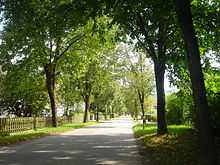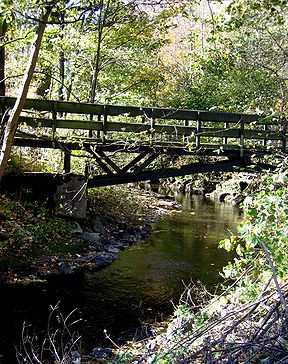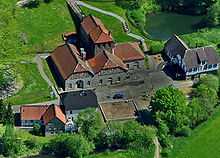Balve
| Balve | ||
|---|---|---|
 | ||
| ||
 Balve | ||
Location of Balve within Märkischer Kreis district 
 | ||
| Coordinates: 51°20′0″N 07°52′0″E / 51.33333°N 7.86667°ECoordinates: 51°20′0″N 07°52′0″E / 51.33333°N 7.86667°E | ||
| Country | Germany | |
| State | North Rhine-Westphalia | |
| Admin. region | Arnsberg | |
| District | Märkischer Kreis | |
| Subdivisions | 7 | |
| Government | ||
| • Mayor | Hubertus Mühling (CDU) | |
| Area | ||
| • Total | 74.76 km2 (28.86 sq mi) | |
| Elevation | 240 - 546 m (−1,551 ft) | |
| Population (2012-12-31)[1] | ||
| • Total | 11,566 | |
| • Density | 150/km2 (400/sq mi) | |
| Time zone | CET/CEST (UTC+1/+2) | |
| Postal codes | 58802 | |
| Dialling codes | 02375 | |
| Vehicle registration | MK | |
| Website | www.balve.de | |
Balve is a town in the Märkischer Kreis district, North Rhine-Westphalia, Germany. It is located in Hönnetal, a narrow valley created by the river Hönne, which is near the Sorpesee, formerly part of Balve, and at the north end of the Sauerland, near Dortmund. The town was established in 1975 with several divisions including Balve, Beckum, and Eisborn.
History

The first disputed reference to Balve was in around 780, when it was mentioned that a Widukind owned a farm called Ballowa, another name for the town.[citation needed] The first undisputed reference was in 864, in which a blind girl from Balve was said to be healed at the grave of the Saint Ludger in the crypt of Werden Abbey.[citation needed]
Ballowa is also mentioned in the Thidrekssaga, a chivalric saga written in the mid-13th century in Norway. In the saga, Ballowa is the home of two dwarfs who taught Weyland much about making iron weapons. At the time of writing, Balve belonged to the county of Arnsberg.[citation needed]
In 1358 the town became the property of the Duchy of Westphalia, which belonged to the Archbishops of Cologne. In 1430 it was given the right to be called a city. During the Napoleonic period, it belonged for a short time (1802–1815) to Hesse, after which time it became part of the Kingdom of Prussia.[citation needed]
In 1975, during a local government reorganization, the city was enlarged by the addition of the several former independent municipalities from the abolished Amt Balve, including Asbeck, Beckum, and Eisborn.[citation needed]
Organizations, economy and transportation

Local organizations include a Red Cross chapter, and the Schützenbruderschaft St. Sebastian Balve, founded in 1947.[2] Primary schools in the town include Grundschule Balve and Grundschule Beckum. Several international companies have roots in the town, including Balver Zinn, Chemie Wocklum, and Kruse Group.[citation needed]
Train stations in Balve include Binolen, Volkringhausen, Sanssouci, Garbeck and Balve, the latter station part of the Hönnetalbahn (RB 54) line.[citation needed]
Religion

The main religion in Balve is Roman Catholicism. The church Saint Blaise, built in the 12th century and an example of Romanesque architecture, was consecrated to Mary. On February 3 each year a special ceremony is held in the church, called the Blessing of the Throats. The altar servers of Saint Blaise visit other cities every year, for example Georgsmarienhütte in 1982. Bones from Benedict of Nursia and Saint Blaise, and a 400-year-old monument for Hermann von Hatzfeld, are located in the church. Additionally, two Roman Catholic parishes have been present in Balve for several years.[citation needed]
A Lutheran church is located at Hönnetalstrasse near to the Gemeindezentrum.[citation needed]
Culture
Performing arts

The Männerchor 1860 Balve is the largest choir in Balve. Other choirs include the Männerchor Garbeck and MC Cäcilia Volkringhausen. The town's bands include Musikverein Balve and Musikverein Garbeck.[citation needed]
Until 2005, the organization Festpiele Balver Höhle and the town of Balve have jointly hosted a jazz festival.[citation needed] Acts at the festival have included performances by Jan Garbarek and by Piirpauke. One of the theatre ensembles in Balve is the Kolpingtheatergruppe, directed by Christoph Rapp. Another form of entertainment, the Balver Märchenwochen, involves performing fairy tales at Christsmas.
Festivals
The Festspiele Balver Höhle is held at the Balver Höhle, a cave in Balve. The festival is a major focus of the culture in and around the town, featuring music and theatre performances. The only marksmen's festival, Schützenfest, is also held in a cave, and is organized by Schützenbruderschaft St. Sebastian.
A large bonfire on Easter Sunday is another tradition in Balve, organized by the Kolpingsfamilie Balve. On May 1 each year the fire brigade of Balve is invited to the Feuerwehrfest, and for 20 years a christmas market has organized by Balver Fachhandel that features a live nativity scene.
Sports
One of the soccer clubs in Balve, SG Balve/Garbeck, won the DFB-Ü 40-Cup in 2007. The town also organizes the Balve Optimum, a competition between horse riders.[3]
Participiants in the Balve Optimum have included:
- Horse jumping
- Reiner Klimke
- Paul Schockemöhle
- Ludger Beerbaum
- Markus Beerbaum
- Jessica Kürten (2007)
- Hugo Simon (2008)
- Meredith Michaels-Beerbaum (2008)
- Eva Bitter (2008)
- Dressage
- Isabell Werth (2008)
- Matthias Alexander Rath (2008)
Points of interest

There are many caves in the Hönnetal, including the Balver Höhle at Helle, a large cave used for cultural events such as concerts, stage acting and the annual marksmen's festival, and the Reckenhöhle, a cave 1,478 ft in length that has flowstone. Experts have found signs of cannibalism in some of the caves.[citation needed]
Other points of interest include
- The walls of an old Germanic farm, located Garbeck,[citation needed]
- Beckum, where scientists found bones from eight kind of species of dinosaurs from the cretaceous,[citation needed] and
- The Luisenhütte, the only surviging 18th-century blast furnace that is still in workable condition, situated close to the 14th-century castle Schloss Wocklum, the home of Count Dieter von Landsberg-Velen.[citation needed]
-

Schloss Wocklum
-
Luisenhütte
Coat of arms
The town's coat of arms references the history of Balve. The eagle is taken from the arms of Arnsberg, and the black-and-white cross from that of Cologne. Both symbols were present in old seals of the city, of which the oldest known example dates from 1462. The coat of arms was officially granted on June 24, 1911, and confirmed on February 6, 1976, after the local government reorganization of 1975.[citation needed]
The bottom part of the coat of arms of the former Amt Balve is identical Bolve's town arms. The top half showed St. Peter, wearing a red coat and holding in his left hand a golden key and in his right a golden book. This coat of arms was granted on March 5, 1957, and expired when the Amt was dissolved in 1975.[citation needed]
Persons of interest
- Jean-Marc Gaulin (1962-), Canadian ice hockey player born in Balve
- Franz Hoffmeister († 1943), Roman Catholic priest
- Theodor Pröpper († 1979), composer
- Hermann Wedekind († 1998), actor, opera singer and theatre director
References
- ↑ "Amtliche Bevölkerungszahlen". Landesbetrieb Information und Technik NRW (in German). 31 July 2013.
- ↑ "DIE ENTSTEHUNG DER SCHÜTZENBRUDERSCHAFT BALVE" (in German). www.schuetzen-balve.de. Retrieved 2012-12-14.
- ↑ "DM Dressur Balve: Werth und Rath holen Titel 2008" (in German). Reiterpost. Retrieved 2012-12-14.
External links
| Wikimedia Commons has media related to Balve. |
- Official site (German)
| |||||||

